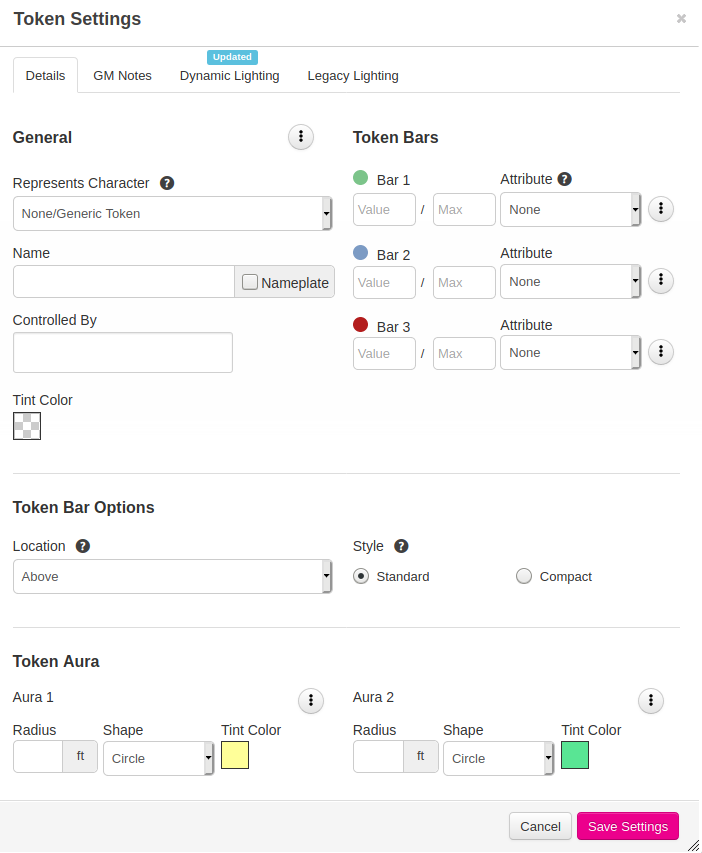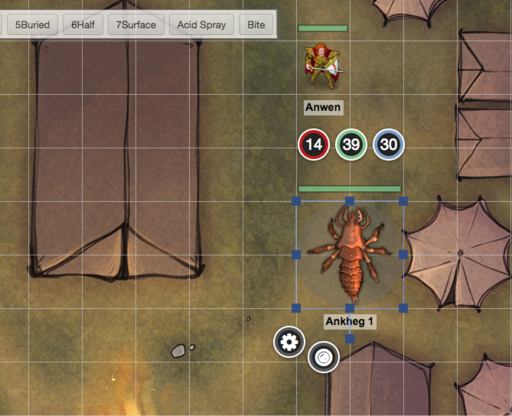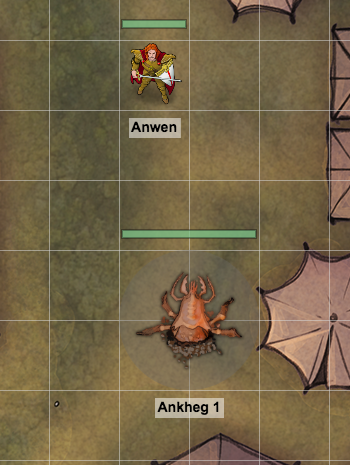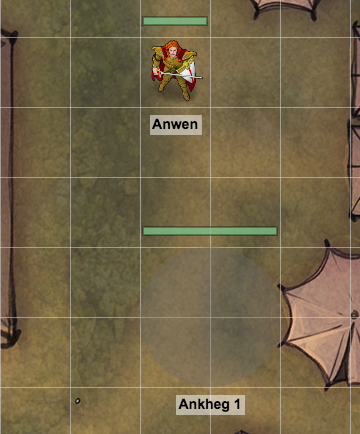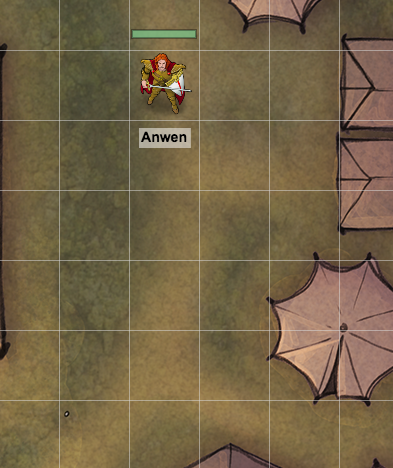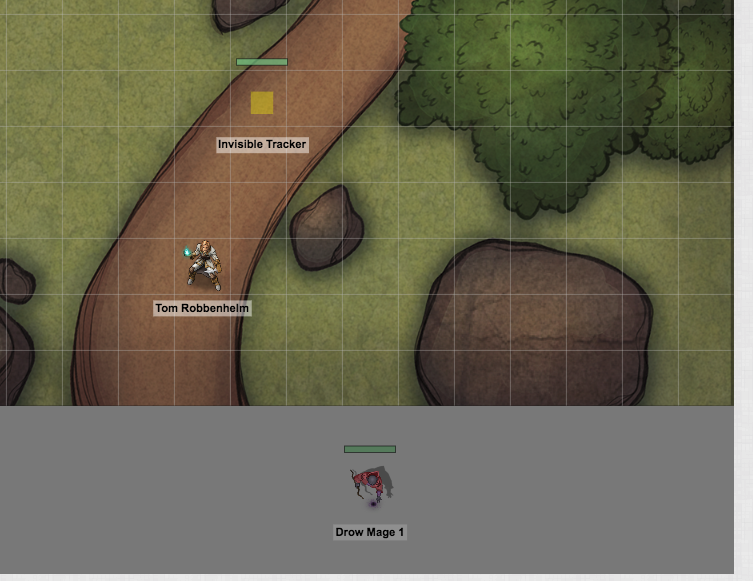Difference between revisions of "Invisible Tokens"
From Roll20 Wiki
Andreas J. (Talk | contribs) (copy several tricks to the actual page) |
Andreas J. (Talk | contribs) m |
||
| (4 intermediate revisions by one user not shown) | |||
| Line 1: | Line 1: | ||
| − | {{#evp:youtube|rwjaewyYRpQ|Invisible Tokens in Roll20, Nick O.|right|500}} | + | {{revdate}} |
| − | + | {{#evp:youtube|rwjaewyYRpQ|Invisible Tokens in Roll20, Nick O.|right|500}} | |
This page has a collection of tips & tricks for creating & using invisible tokens in your games. So of the tips are related to just "hidden" characters/NPCs, and could be moved to a separate page. | This page has a collection of tips & tricks for creating & using invisible tokens in your games. So of the tips are related to just "hidden" characters/NPCs, and could be moved to a separate page. | ||
=Basics= | =Basics= | ||
| − | {{forum|permalink/6474374/ Credits to keithcurtis}} | + | {{forum|permalink/6474374/ Credits to keithcurtis}}[[File:Invisible-token.png|right|thumbnail|right-click on this image to save it as an invisible/transparent token]] |
Of what use is a token you can't see? Plenty, if you are the '''[[GM]]'''. In fact, there are so many uses, that this is likely to be the first post in a series, covering the creation of and control of an invisible token. But in brief, a GM can attach actions, notes and other information to an invisible token, as well as use its other properties, such as aura and light. | Of what use is a token you can't see? Plenty, if you are the '''[[GM]]'''. In fact, there are so many uses, that this is likely to be the first post in a series, covering the creation of and control of an invisible token. But in brief, a GM can attach actions, notes and other information to an invisible token, as well as use its other properties, such as aura and light. | ||
| Line 157: | Line 157: | ||
* [[TokenMod]] - A popular API for managing & editing your tokens with API commands | * [[TokenMod]] - A popular API for managing & editing your tokens with API commands | ||
* ''Bump'' - a way to invisibly manipulate tokens on the GM [[Layer]] from the Objects Layer ({{forum|permalink/8584976/ Bump API}}-forum thread from 2020) | * ''Bump'' - a way to invisibly manipulate tokens on the GM [[Layer]] from the Objects Layer ({{forum|permalink/8584976/ Bump API}}-forum thread from 2020) | ||
| − | * ''' | + | * '''[[DoorKnocker]]''' -- Script helps quickly open and close doors by controlling the dynamic lighting lines. Have options for creating [[windows]] too |
=Related Pages= | =Related Pages= | ||
* [[Tokens]] | * [[Tokens]] | ||
* [[UDL|Updated Dynamic Lighting]] & [[LDL|Legacy Dynamic Lighting]] | * [[UDL|Updated Dynamic Lighting]] & [[LDL|Legacy Dynamic Lighting]] | ||
| + | * [[Forum Tricks]] | ||
<br> | <br> | ||
<br> | <br> | ||
| Line 168: | Line 169: | ||
[[Category:Guides]] | [[Category:Guides]] | ||
[[Category:Tokens]] | [[Category:Tokens]] | ||
| + | [[Category:Featured articles]] | ||
Latest revision as of 16:24, 5 December 2021
Page Updated: 2021-12-05 |
This page has a collection of tips & tricks for creating & using invisible tokens in your games. So of the tips are related to just "hidden" characters/NPCs, and could be moved to a separate page.
Contents[hide] |
[edit] Basics
Credits to keithcurtis(Forum)Of what use is a token you can't see? Plenty, if you are the GM. In fact, there are so many uses, that this is likely to be the first post in a series, covering the creation of and control of an invisible token. But in brief, a GM can attach actions, notes and other information to an invisible token, as well as use its other properties, such as aura and light.
Creating the token How to create an invisible token? First you need a completely transparent png. Here's one you can download. Trust me, it's really invisible. (The Aaron has used dark magic to make it appear within the forum.)
Click on it to see the invisible preview, then right-click on it to download it to your computer. Then upload it to your P Art Library, and drag a copy onto your tabletop. Depending on what you want to use it for, you may want to right-click on the tabletop copy and define it as "is graphic" or leave it as a token. It all depends on if you want the little bars, bubbles and gears to appear when you select it.
Seeing the Invisible Now finding the darn thing would be problematic to say the least. It's invisible. That's where auras come in. Go ahead and double click on it to bring up the editing interface. Give Aura number one any value, probably of zero, though you can use negative number. if you want it a bit smaller. You can also give it a name at this time, depending on what you want to use it for. You'll be able to see it just fine, but your players won't.
Attaching it to a Sheet Eventually, you will probably want to attach this to a sheet, but again, you may want to have different kinds of sheets for different purposes. The absolute biggest advantage to attaching it to a sheet is that you can pull a fresh token from your N Journal-tab whenever you want, without going through all the steps above. For our initial examples, we will be creating an otherwise-empty character sheet called "Info". Attach the token to this character sheet and save it as the default token for the sheet. Your Token Settings should look like the image to the right.
So now you have an invisible token attached to a character sheet no one can use. What do you do with it? Plenty. Read on.
[edit] Notes token
Invisible Tokens - Notes Token(Forum) by Keith
Using inv tokens to create easy-to-access notes whispered to the chat with token actions. See link for full trick.
[edit] API Version
API version(Forum) by Keith
[edit] Control token
Invisible Tokens - The Control Token(Forum) by Keith
See link for full trick.
The Control Token is simply a specialized use of the Notes Token. It really requires the API, since it is used to control scenario specific events. In the previous tip, I showed how to place and retrieve info from the GMNotes field of a token. That info can be used with other scripts to play sounds, change graphics, create mood lighting, control doors and much more.
[edit] Door Control
Invisible Tokens - Door Control(Forum) by Keith
See link for full trick.
Most Door scripts have the same basic approach. You link a door open image, a door closed image, and a bit of Dynamic Lighting line. The script shuffle them around between layers to swap the opened and closed door images from the Map Layer to the GM Layer, and doing similar with the DL line.
The problem is, many maps come with baked-in door images. You can add and remove Dynamic Lighting Lines, but the door is there and you don't want to spend hours altering the map.
[edit] Invisible Creatures
Credits to keithcurtis(Forum), see also video doing the same thing by Nick O.
Sometimes creatures are on the battlefield but can't be seen. Maybe they are tunneling, or ethereal, or just plain invisible. The Aaron has a good script for that call Bump, but here's a method that can be used without the API (but with the API, still much easier).
For a creature that has this capability, create a Rollable Token, with the invisible face as one of the sides. Create a GM-only aura around it, preferably taking up its exact space. Set up your token in whatever fashion you do normally, and save it as the default token. Now whenever you drag that token to the battlefield, it will have the capability of turning invisible. There are two methods, the Manual (Free) method, and the API (Pro) method. (There is also the quick and dirty Fog of War method I mention here, but this is easier to use with multiple creatures.)
Manual Method (Free) The manual method is two step. First right click the token and call up the token menu. Choose "Multi-Sided >> Chose Side". If it is visible, choose the other side, and vice versa. This will toggle the token between the creature and the invisible state. The GM Aura us placed on it comes into play here, because YOU need to see where it is. The second step is the name plate. Most GMs in my experience, make the name plate visible to all players. You'll need to open the token interface and set the nameplate to invisible to players. This helps the players say "I want to attack Ankheg #4". They could ping it for the GM, but words are faster. Of course, you'll need to turn that back on when making the token visible again. For a battlefield with more than one invisible token creature, it might be easier to just leave the nameplate invisible and ping targets for the GM.
API Method (Pro)
The API method is much easier. You write a token macro that uses TokenMod to set the face and the nameplate. You could name one macro visible, the other invisible. Here is sample code:
!token-mod --set currentside|1 !token-mod --set showplayers_name|yes
The "1" and "yes" are what you need to change from macro to macro. The number in the first line sets the face, the "yes" in the second line should be changed to "no" when setting the face to invisible. Note that TokenMod will only change images that are in your P Art Library; you may have to download and re-upload any purchased assets you wish to use this trick on.
In the example images below, I have actually used three states. The Ankheg is a burrowing creature, and I happily had an erupting state for the image. So I have three buttons, "Buried", "Half', and "Surface". This is one advantage of this method over The Aaron's excellent Bump script. I use a very subtle GM aura, since the nameplate remains visible to me.
[edit] Noises in the Dark
Noises in the Dark(Forum) by Devin S.
A very simple trick - and probably widely used - but after turning on Dynamic Lighting for the first time, I wanted a way to show players where the noises they were hearing in the dark were coming from.
To solve that, create a square black token with the word "noise" written in it. Drop the picture into your game, have it radiate a 1' diameter light that players can see, give it two black auras of 1', then assign it to a character (just like your Invisible Icon). Now you can drop it onto the map and the characters can see it, even if their light doesn't reach that area.
[edit] Hide Token with Map Assets
Trick(Forum) by Anton Palikhov
- How I used token aura trick. I created matrix 5x5 filled with giant runes (as in SKT hardcover - I found somewhere in Internet font with giant runes which helped a lot with creating), then created a riddle to hide correct path about those matrix. and finally i created hint about "Lantern of Revealing" - player controlled token with aura on map.
- Players were satisfied with such riddle and said that this encounter was amazing, but it take a lot of work from me.
- Another trick - I sometimes use map assets (trees for example) on token layer to hide tokens of enemies. When players find enemy scout or spy on map by themselves (not by perception check) - they usually began to look on map more and more and have more fun when found another little hints which were set by me before game.
[edit] Hidden Light Source
trick(Forum) by El Gato of de Churros
Sometimes you wish to have a light source for dynamic lighting, but do not wish to have it come from a visible map item. Perhaps it comes from an overhead chandelier, or a glowing bed of lava that is part of your map, or perhaps sun or moonlight streaming in through a window. An invisible token can emit light like any other token. Jeremy reminds us that this can be given a GM-only aura as described here. If you feel that the aura is distracting, or you do not wish to accidentally move it, it can be placed upon the Dynamic Lighting Layer. The aura will not show here, so remember where you have put it! godthedj and Kyle G. further suggest that you can use the map layer for identical behavior. Tokens placed upon the GM layer will not emit light.
After reading these, I would suggest placing it upon the DL Layer, since tokens on the DL Layer are invisible to both GM and player naturally. In this way, you can use any token you like invisible or not, and with or without aura. It will only be visible while you are on the DL Layer, and will still shed visible light.
[edit] Token Aura
Tips(Forum) by rabualis | See Link ofr full trick
how to use Token Auras with invisible tokens to make tokens visible for only some players & the GM.
[edit] Creating Hidden Messagess
[edit] Using Turn tracker for planned actions & hiding characters
Tips by Mel C.(Forum)
- Turn Tracker on Multiple Pages:
- Turn Tracker can track tokens from any combination of pages, and there’s no need to close it when switching between pages. The GM sees all items in the list, but players will only see the items that are located on their current page.
So this can be useful in several ways by creating a page called something like "map 3 encounters" and putting tokens on it to represent the NPC. These are in addition to the NPC tokens on the actual page you are playing on.
1. Over come the problem of hidden/not visible NPC having their location revealed by selecting in the [[Turn Tracker}}. Instead of rolling initiative for the token on your game page roll it for the equivalent token on the "map 3 encounters page".
Since the token is not on your game page its position can't be revealed.
2. Using above also means that a NPC turn is only shown to the GM. This is more realistic even when you have visible NPCs as the PCs wont know when its the NPCs turn on the 1st round.
Planed actions.
You may have prepared a series of events that are going to occur but it can be hard for the GM to keep track of this in something like combat. In a scenario you may decided that there will be 3 badies in a room, combat inevitable starts, 2nd turn 3 more badies enter stage right, 4th turn more badies are due.
3. In this case you can use the turn counter and use tokens with names that state the turn and action e.g. "3 badies on turn 2". Again this only appears on the GMs turn tracker and acts as a reminder.
4. Reminder for more complex sequences. Its not too bad for the GM when its only grunts where the options are run away or who to attack. But suppose its more complex:- "wizard invisible enters turn 3", "wizard levitates turn 4", "wizard casts fire ball turn 6".
5. Or a reminder that some thing will happen such as "shape shift ends turn 5"
Also for mechanical sequences such as a machine doing something after a certain number of turns.
Note that you can manually change a characters position in the tracker so you can still group all the NPCs in the same turn if you want.
I used long token names so its clear on this thread. In reality it may be your own shorthand like "wiz4levi".
[edit] Quick & Dirty Tracking Using FoW
Invisible trick FoW(Forum) by keith | Nick O's video displaying the same trick Invisible Tokens in Roll20 5:57
Often you need to make a token invisible, or ethereal or just plain hidden from player view. Still, you want to be able to track it's movment and have access to its token macros, bubbles or other token features. The basic way to handle this is to temporarily move it to the GM layer, where you can see it but the players can't. It can be a bit of a hassle to keep shifting layers, however, especially if you are not comfortable with hotkeys or advanced hotkeys. There are some great scripts like Bump(Forum) for this if you are a pro subscriber, but it you are Plus or Free, what to do?
One workaround is to make a strip of Fog of War across one side of the map. Any token you want to be invisible can be moved there. Then just use a placeholder with a transparent png for its face and an GM-visible-only aura to move around the map. Make sure you have the aura and the token name set to be invisible to players. You can even make the placeholder token a standard token you can draw from you library at a moment's notice. Just set it up as indicated, attach it to an otherwise unused character sheet and set it up as the default token for that sheet.
This allows you to have access to the real token and its attendant character sheet and token macros without mucking about with rollable tables and faces, or moving things between layers. You can make any token invisible or ethereal at a moment's notice. Just drag them into the FoW area, which to the players just appears as a black band on one side of the map. Then drag out your placeholder token and continue playing.
In the screenshot, a sneaky drow mage is attempting to evade poor Tom Robbenhelm. He has become invisible and is just standing on the open path. I have moved his token to the Fog of War area down at the bottom of the page, and moved an Invisible Tracker token to take his place. I can still click on his token and use the Witch Bolt macro I have created for him, without having to change layers or reveal his true position. Conversely, if Tom Robbenhelm unleashes a fireball in the general area he believes the drow to be standing, I can easily click on the drow token and subtract the appropriate damage from his damage bubble.
[edit] Useful API
API that can be helpful for enhancing invisibility-related stuff
- TokenMod - A popular API for managing & editing your tokens with API commands
- Bump - a way to invisibly manipulate tokens on the GM Layer from the Objects Layer (Bump API(Forum)-forum thread from 2020)
- DoorKnocker -- Script helps quickly open and close doors by controlling the dynamic lighting lines. Have options for creating windows too
[edit] Related Pages






